The ancient Egyptians communicated a wealth of knowledge, beliefs, and cultural values through an intricate system of symbols, each carrying a depth of meaning far beyond its surface appearance. This linguistic landscape, painted with a broad palette of symbols ranging from the tangible to the abstract, offers a window into the soul of a civilization that has long fascinated scholars and laypersons alike.
Form Symbolism
Ancient Egyptian art is rich with symbols, a language in itself, translating complex messages and beliefs to those who understand its nuances. A foundational aspect of this symbolic communication lies in the concept of form symbolism. This is realized through two primary tiers: direct (primary) and indirect (secondary) representation.
The djed pillar, an emblem of stability and durability, serves as an example. On the direct level, its appearance suggests this meaning, serving as a backbone or axis of the world, epitomizing both physical and celestial stability. Conversely, the clenched-hand amulets speak on an indirect level; although they portray a simple closed hand, they hint at themes of protection and sexual union, engaging in a dialogue beyond their immediate form.
The complexity of Egyptian symbolism is further exemplified through the deity Hathor. Hathor, often symbolized by a cow, embodies motherhood and fertility. Yet, this deity's symbolism extends to music, dance, and foreign lands – areas vastly different in nature but collectively representative of Hathor's domain. Such breadth exhibits Egyptian art's capability to encompass multifaceted concepts within a singular symbol, be it an animal, plant, or object.
Modification of forms presents another layer of meaning. For instance, the artistic depiction often manipulated the location and color of solar disks within tombs to symbolize cosmic realms. Similarly, columns in temples transition from bud forms to fully opened capitals, mirroring the cyclical nature of life and the cosmos.
This secondary level of symbolism hints at how Egyptians perceived and interacted with their environment. It's not merely about what the images directly represent but about invoking the interconnectedness of all things. The contrast between static form in direct symbolism and dynamic association in indirect symbolism encapsulates the duality prevalent in much of Egyptian thought—constancy versus change, temporal versus eternal.
In essence, Egyptian art wields form as both mirror and window; a reflection of their world and a portal to a realm rich with meanings and associations waiting to be decoded. Through every statue, painting, or artifact—whether showcasing the might of a pharaoh through size or expressing mythological concepts through the intertwining of human and divine figures—the art of ancient Egypt speaks a language where every line, every color, and every form is a word teeming with narratives of a civilization deeply intertwined with the symbolic.
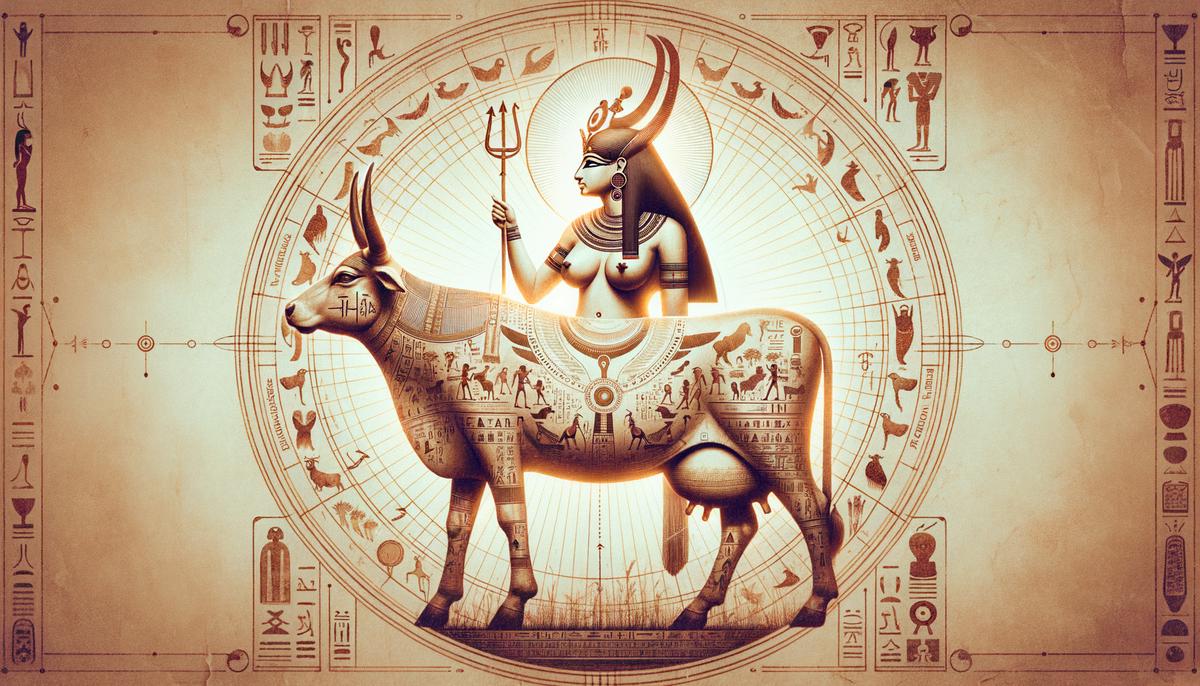
Hieroglyphic Symbolism
Hieroglyphs, the dexterous symbols that inked their permanence across millennia, are pivotal in demystifying the enigmatic heart of ancient Egyptian art. As specialized subsets of form symbolism, hieroglyphic syntheses brew a complex concoction of visual storytelling and divine invocation, seamlessly intertwining the mundane with the celestial.
At the forefront, ideographic representation captures our fascination—each hieroglyph functions as a direct portrayal of the material or metaphysical. These symbols embody the essence of gods, men, beasts, and concepts, articulating tales that span the ethereal and the earthly.
Intriguingly, hieroglyphs also delve into the art of rebus representation—a fusion of phonetics and imagery painting narratives in strokes of ingenuity. Here, figures and objects amalgamate, their sounds interlocking to spell out titles or names, crafting a visual dialogue that resonates with vibrational harmony. This linguistic ballet, the rebus technique, testifies to the Egyptians' acumen in interweaving wordplay with iconography.
Hieroglyphic symbolism sometimes adopts the cloak of visual metaphor and analogy. The latter particularly showcases the Egyptians' proclivity to mirror reality in the tapestry of their art. Items morph into hieroglyphic incarnations of themselves, fulfilling dual purposes: a physical utility while simultaneously anchoring abstract connections. For instance:
- A mirror crafted in the shape of the ankh sign (life)
- A headrest echoing the horizon
The forms assume symbolic testament. Thus, through this duality, objects are not mere material; they metamorphose into ideological emissaries conveying insights into existence and beyond.
This journey of inscription extends beyond crafted artifacts, veiling natural forms with symbolic relevance as the ancient Egyptians projected hieroglyphic forms onto them. The observable world unfurled as a living canvas, every creature, every configuration, a visual lexicon paying homage to their cosmic conceptions. Such projection underscores a society profoundly reflective, seeing themselves as integral elements within a broader symbolic matrix.
Hieroglyphs spoke a privileged language, primarily the purview of the educated elite—scribes, priests, and nobility who were adept in weaving and unwrapping these complex symbolic narratives. Yet, echoes of these sacred symbols reverberated through the layers of society. It is conceivable that even those not versed in formal literacy perceived echoes of this system's essence. Common symbology—basic forms representing universal concepts such as life (ankh), stability (djed), and protection (Eye of Horus)—permeated understanding to varying degrees, instilling a collective reverence for these icons that saturated their cultural reality.
The role hieroglyphs played within this grand symbolic convergence was neither mere documentation nor decoration. It was a confluence of divinity, nature, and humanity—a dialogic pulse embodied in stone, papyrus, and the very soul of Egypt. With every image, every symbol cast, ancient Egyptians invoked an intricate world view, harmonizing the visible with the invisible in a transcendent hieroglyphic symphony.
Through this venerable script, modern onlookers peer into a world where every sign is a symphony, every glyph a doorway to transcendence—an eternal bridge between man, myth, and the meanings that meander beneath the veneer of existence.
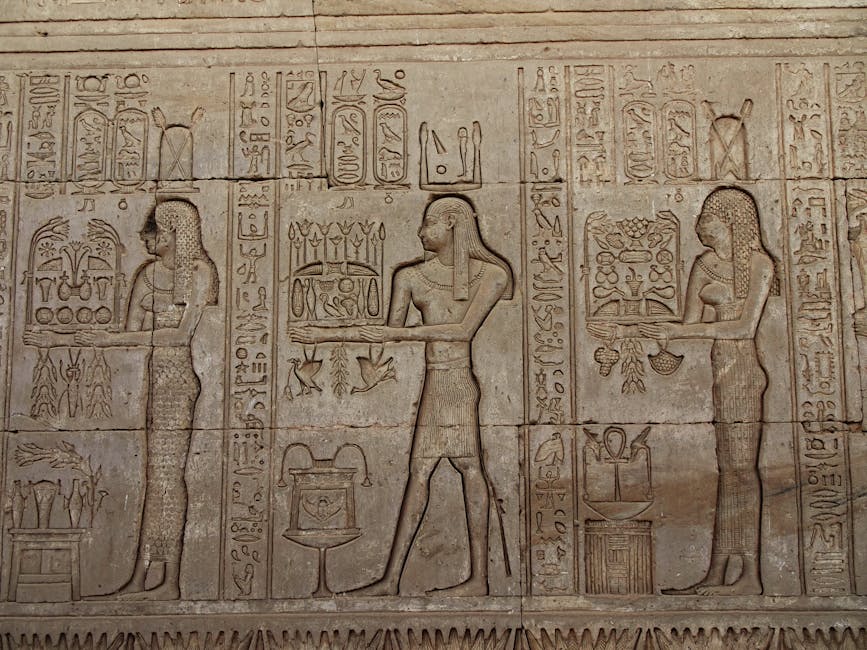
Colour and Material Symbolism
The ancient Egyptian palette, far from being mere ornamentation, was a carefully curated language of hues and matter, each resonating with profound symbolic undertones. In the hands of master craftsmen, color and material transcended the visual, becoming threads woven into the very fabric of their cosmology. Delving into this chromatic and material discourse reveals the nuances of meaning that color and material imparted, epitomizing a civilization deeply attuned to the symbolic resonance of their surroundings.
In the realm of color, the Egyptians wielded hues with precision and purpose, imbuing their works with layered meanings.
- Blue and green were not merely representations of water, sky, or vegetation; they were the essence of creation itself, epitomizing fertility, rebirth, and the lushness of life that the Nile bestowed upon the land. These colors bore divine annotation. The deep, celestial blue, reminiscent of precious lapis lazuli, transcended earthly bounds, linking artifacts and deities with the infinite expanse of the heavens, thus embodying the divine essence.
- Green maintained a vivid presence in Egyptian artistry, signifying growth, health, and the unfurling of life's potentials. Predominantly featured in contexts associated with rejuvenation and eternal life, this color echoed the immutable cycle of death and rebirth that deeply rooted the Egyptian understanding of existence.
- Gold, the flesh of the gods, glistened with unparalleled prestige within this symbolic framework. Its imperishable luster spoke of eternity, an incorruptible divine essence that was not only bestowed upon deities but also royally claimed by pharaohs in their god-like stature. Gold immortalized its subject, making it a beacon of immortality that gleamed across temples, pyramids, and even within the intricate adornments encasing mummies.
Parallel to the narrative of color runs the symbolism imbued in material choice. Ephemeral and eternal textures intermixed in Egyptian art, manufacturing a tangible dialogue with divinity and the natural order.
- Gold and silver – metals that do not tarnish – reiterated themes of eternal brilliance and immutability. Like gold with its sun-like radiance suggesting an unending cycle of rebirth, silver, too, held its symbolism, often connected with the moon's ethereal glow and associations with purity and natural cycles.
- Basalt, with its velvety black sheen, was not just striking to gaze upon but represented the fertile black silt of the Nile – hence symbolizing regeneration and rebirth.
- Lapis lazuli, specked with golden pyrite against azure depths, mirrored the star-studded heavens above, serving as a cosmological map linking the bearer to the celestial realms.
Every material selected for its singular resonance, every hue chosen for its symbolic depth performed in unison within the grand amphitheater of Egyptian culture. As we meander through their storied landscapes, observing the teal-infused faience, the gleam of golden tombs, and the profound blacks of basalt statues, we walk a path illuminated by metaphorical brilliance—a verdant journey through a civilization where every artistic decision encapsulated a universe of meaning.
These symbolic allocations breathed with societal shifts, adapting and reshaping under temporal influences. What remained constant was their function: as vessels of meaning, carriers of belief, and markers of an intricate cosmic dialogue. Through the lens of color and material, ancient Egyptian art invites us on a transcendent exploration beyond aesthetic allure into realms where the invisible is rendered visible, where the mundane melds with the divine.
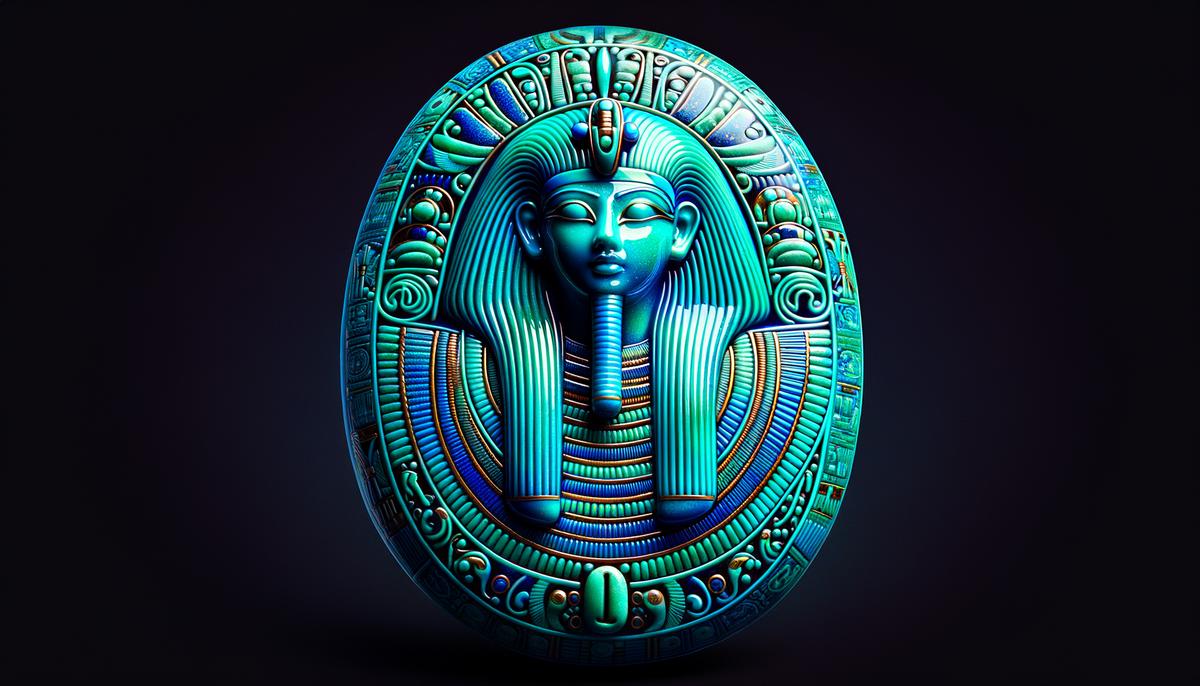
Symbolic Representation of Numbers
In the worldview of ancient Egypt, numbers were not merely mathematical symbols but held profound metaphysical meanings, functioning as the cosmic codes that underpin the fabric of reality. The Egyptians perceived numbers as intrinsic elements of the universal order, imbued with both spiritual potency and symbolic significance. This section delves into the sacred arithmetic that animates Egyptian art and architecture, unveiling how numbers such as 2, 3, 5, and 7—along with their multiples—articulate the nuances of unity, plurality, and divine harmony in the visual and structural language of this ancient civilization.
At the core of Egyptian cosmology lies the concept of duality, encapsulated by the number 2. This principle mirrors the belief in the essential balance between opposing forces: order and chaos, light and darkness, death and rebirth. Artistic depictions harness this symbolic dichotomy, often presenting deities in pairs to convey complementary aspects of existence. Architecturally, temples often featured twin structures or symmetrical gateways, underscoring the cosmos's inherent dual nature. Thus, the number 2 invokes the Egyptian pursuit of harmony within the universe's polar forces, a theme recurrently echoed in their mythos and artistic expressions.
Venturing beyond, the number 3 in Egyptian symbolism captures the essence of completeness and plurality. This is most vividly observed in their portrayal of divine families, epitomizing the totality of cosmic dimensions – the heavens, the earth, and the underworld. Triads such as Osiris, Isis, and Horus embody this concept, narrating a continuum of life, death, and resurrection. Similarly, pyramids—the quintessential emblems of Egyptian ingenuity—are based on triangular geometry, their three-sided shapes ascending towards the sun, a reflection of the trinity embodying spiritual ascension and divine connection.
Progressing to the number 5 reveals its association with humanity and the material world, derived from the human body's natural quintuplicity: two arms, two legs, and a head. This number features in artifacts and amulets designed to protect and celebrate human life, encapsulating health, senses, and the physical experiences defining earthly existence. The Egyptians also envisioned the universe as comprising five elements: air, earth, fire, water, and ether, further delineating number 5's symbolic relevance to cosmological principles governing harmony and balance in the material plane1.
The number 7 signifies a leap into complexity and multiplicity, embodying sacredness encapsulated in cycles and rites. This number appears in religious contexts, signifying the layered stages of spiritual journeys and the unfolding of celestial mysteries over time. Architectural designs often incorporate septenary principles, structuring spaces that sequentially unveil deeper sacred meanings, guiding the soul's progression towards enlightenment.
In the grand narrative of ancient Egyptian symbolic lexicon, numbers transcend their quantitative identity, emerging as keystones of spiritual philosophy and cosmological thought. Through their integration in art and architecture, numbers encode messages of divine orders, existential pathways, and universal harmony. Each numeral holds a key to understanding a civilization ardently committed to deciphering the order underlying the cosmos's chaos—an eternal quest mirrored in their monumental legacies.
Thus, to peer into the numerical motifs adorning Egyptian temples or demarcated in their sacred geometries is to engage in a dialogue with an ancient intelligence dedicated to harmonizing the dance of cosmic forces through the medium of numbers—a legacy that invites modern minds to ponder upon the interwoven tapestry of meaning that once connected a civilization to its conception of the infinite.
- Wilkinson RH. Symbol and Magic in Egyptian Art. Thames and Hudson; 1999.
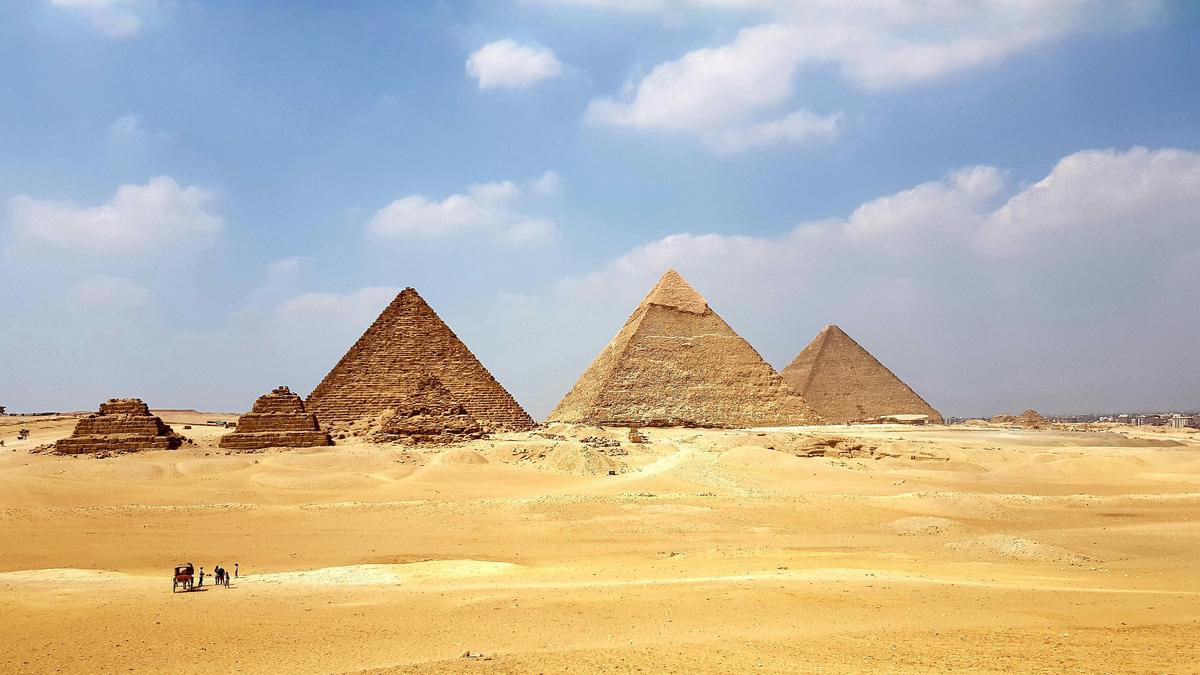
Photo by osamaabosaadia on Unsplash
Symbolic Gestures and Actions
Gesture and Action: The Silent Dialogues of Egyptian Art
In ancient Egyptian art, gestures and actions engage in a profound dialogue imbued with symbolic meanings. This intricate lexicon of non-verbal communication reveals insights into the values and beliefs that defined a civilization. Gestures, captured in stone or papyrus, convey messages ranging from reverence to longing. This exploration delves into the realm of independent and sequential gestures, elucidating how context and composition orchestrate the symphony of silent expressions.
Independent Gestures: Symbols in Solitude
Independent gestures stand as powerful symbols, each carrying a complete message. These gestures require no succession or context to articulate their meanings. A quintessential example resides in the ankh-sign holding gesture—a hand elevating the symbol of life, extending an offer of eternal existence to the depicted individual.1 Similarly, the poised hands of the Osiris figurine, crossed over the chest, bespeak sovereignty in the afterlife, encapsulating Osiris's dominion over death and resurrection. These solitary gestures convey profound narratives, inviting onlookers into a world where stillness speaks volumes.
Sequential Gestures: Narratives in Motion
Egyptian art intricately weaves sequential movements into its narrative fabric. These gesture sequences, observed within ritualistic contexts or mythological retellings, unfurl a panorama of actions where each motion builds upon the next. An exemplary narrative brought to life through sequential gestures is found in ceremonial processions depicted on temple reliefs. The measured steps of priests, their arms raised in veneration, sequentially progress towards the sanctum, each movement a homage to the divine.
The sequential gestures guiding the soul of the deceased through the Book of the Dead represent another profound employment of action narratives. From the weighing of the heart against the feather of Maat to the presentation before Osiris, each gesture segues into the next, charting the soul's journey through judgment.
Context and Composition: The Shaping of Meaning
In deciphering the symbolic language of gestures and actions in Egyptian art, context is crucial. The same gesture can unfurl varied meanings dependent upon its setting and the entities involved. A gesture of adoration directed towards a god encapsulates piety; towards a pharaoh, it signifies loyalty; amongst equals, it may denote respect.
Composition further nuances interpretation, infusing gestures with depth by their placement within the artwork. The intersection of gestures, gazes, and spatial arrangements unlocks a multiplicity of readings, each resonant with cultural and spiritual connotations.
Studying these silent dialogues offers a deeper understanding of a culture where communication transcended spoken words, reaching for a unity of expression between the mortal and the divine, between heart and stone.
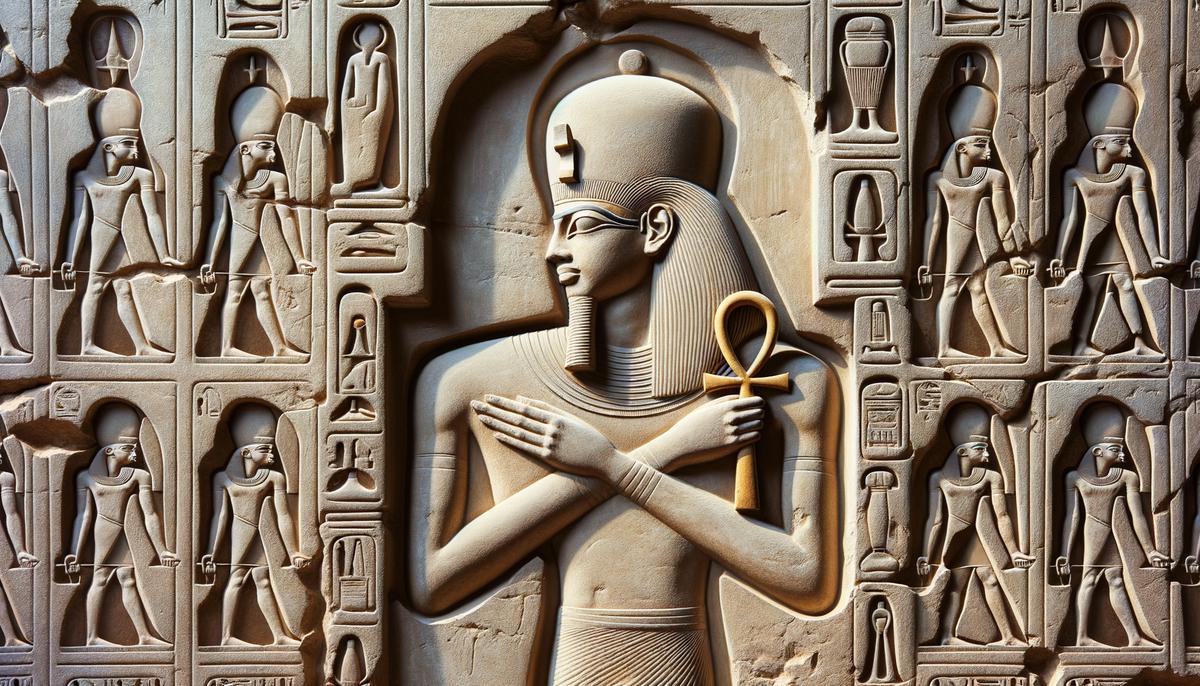
Interpretation Challenges
Interpreting the Enigmatic: Challenges in Decoding Egyptian Symbolism
Unraveling the tapestry of ancient Egyptian symbolic expression is fraught with challenges. Symbols that once pulsed vibrantly through a civilization now present a riddle cloaked in millennia of shifting interpretations. Delving into this narrative reveals a labyrinth of complex undertones and evolving significances awaiting meticulous dissection.
Fluidity Across Millennia: The Evolution of Meaning
One formidable barrier in understanding Egyptian symbolism lies in the fluidity of symbols over time. A symbol that epitomized fertility in one era might evolve, accruing new meanings as dynasties change and society progresses. The scarab, initially revered for its manifestation of the sun god's rebirth, undergoes a metamorphosis in context and implication. It evolves to encapsulate notions of protection, transformation, and guidance through the afterlife—illustrating that symbols are dynamic artifacts of their cultural and historical milieu.
Multiplicity of Interpretations: A Symbol's Many Faces
Adding further complexity is the multiplicity inherent in symbolic representation. A single symbol can don various significances depending on its usage, placement, or association with other symbols. The ankh symbolizing life can concurrently embody the concepts of immortality, the universe's breath, or the key unlocking the mysteries of the afterlife. This polymorphic nature necessitates an interpretive approach that is both flexible and discerning.
Context as King: The Pillar of Symbolic Significance
The key to unlocking a symbol's significance often resides in its context—geographic, relational, or narrative. A deity's depiction in isolation might signify one aspect of their divine responsibility; however, when placed in a tableau amongst peers, the depth of symbolic meaning expands. Understanding spatial arrangements in temple art provides vital cues to hierarchical relationships, theological import, or cosmological significance.2
Navigating Modern Assumptions: The Risk of Anachronism
One subtle yet pervasive challenge in interpreting Egyptian symbolism is the modern observer's propensity to project contemporary ideologies onto ancient symbols. It requires unmooring from present-day biases and immersion in the ethos and worldview of a civilization that flourished millennia ago. Achieving this temporal empathy demands suspending current paradigms to authentically engage with the past's symbols on their own terms.
Interpreting the symbols in ancient Egyptian art is a venture marked by both revelations and mysteries. It necessitates historical understanding, insight into changing symbolic landscapes, and a guard against presentist contaminations. Through this meticulous endeavor, we inch closer to bridging worlds separated by time, unearthing the depth of meanings that ancient symbols cradle.
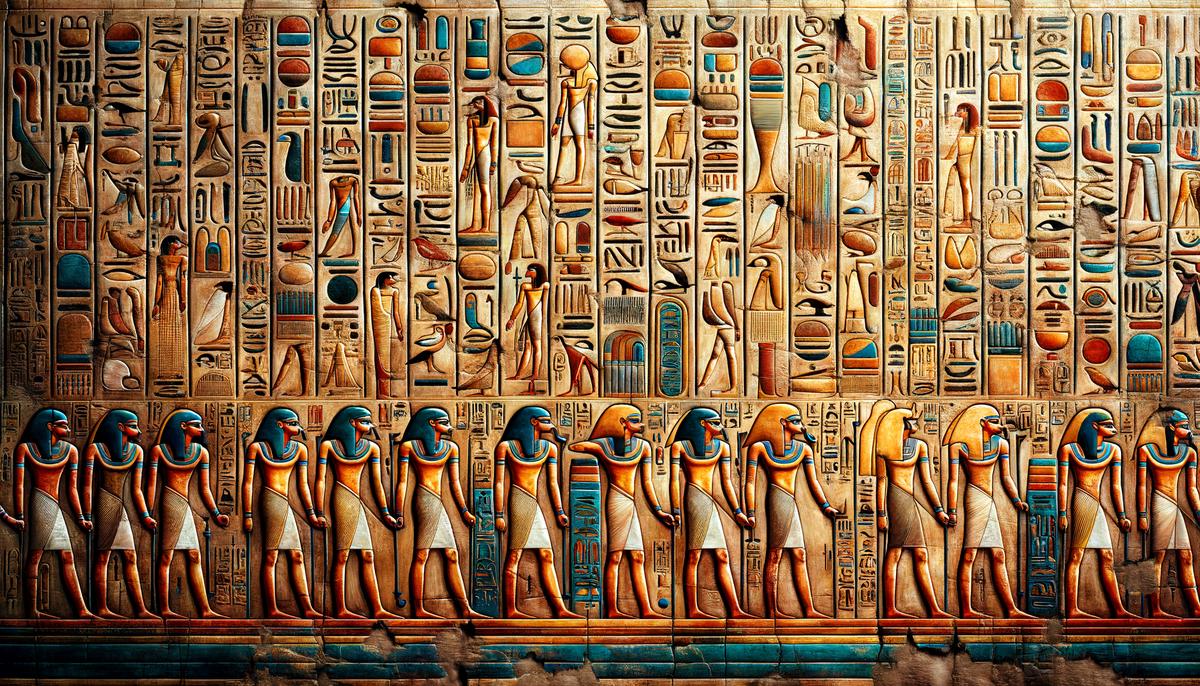
In conclusion, the art of ancient Egypt serves not merely as a repository of historical data but as a vibrant lexicon of symbols, each narrating stories of cosmic order, divine mandates, and human endeavor. The interplay between form, color, material, and number within this symbolic system reveals an intellectual sophistication and a nuanced understanding of the universe. At its core, this symbolic language encapsulates the Egyptians' quest to harmonize the terrestrial with the celestial, a pursuit that remains as compelling today as it was millennia ago.




















